Organocatalytic Synthesis of α-Aminonitriles: A Review
Abstract
:1. Introduction
2. Organocatalyzed Synthesis of α-Aminonitriles via Strecker-Type Reactions
2.1. Synthesis of Chiral α-Aminonitriles
2.2. Synthesis of Racemic α-Aminonitriles
3. Organocatalyzed Synthesis of α-Aminonitriles via Oxidative C–H Bond Functionalization
4. Summary and Outlook
Author Contributions
Funding
Data Availability Statement
Conflicts of Interest
References
- Wang, J.; Liu, X.; Feng, X. Asymmetric Strecker Reactions. Chem. Rev. 2011, 111, 6947–6983. [Google Scholar] [CrossRef] [PubMed]
- Kouznetsov, V.V.; Galvis, C.E.P. Strecker Reaction and α-Amino Nitriles: Recent Advances in Their Chemistry, Synthesis, and Biological Properties. Tetrahedron 2018, 74, 773–810. [Google Scholar] [CrossRef]
- Grundke, C.; Vierengel, N.; Opatz, T. Aminonitriles: From Sustainable Preparation to Applications in Natural Product Synthesis. Chem. Rec. 2020, 20, 989–1016. [Google Scholar] [CrossRef] [PubMed]
- Eppinger, E.; Gröning, J.A.D.; Stolz, A. Chemoenzymatic Enantioselective Synthesis of Phenylglycine and Phenylglycine Amide by Direct Coupling of the Strecker Synthesis with a Nitrilase Reaction. Front. Catal. 2022, 2, 952944. [Google Scholar] [CrossRef]
- Masamba, W. Petasis vs. Strecker Amino Acid Synthesis: Convergence, Divergence and Opportunities in Organic Synthesis. Molecules 2021, 26, 1707. [Google Scholar] [CrossRef]
- Cai, X.-H.; Xie, B. Recent Advances on Asymmetric Strecker Reactions. Arkivoc 2014, 2014, 205–248. [Google Scholar] [CrossRef] [Green Version]
- Fleming, F.F.; Yao, L.; Ravikumar, P.C.; Funk, L.; Shook, B.C. Nitrile-Containing Pharmaceuticals: Efficacious Roles of the Nitrile Pharmacophore. J. Med. Chem. 2010, 53, 7902–7917. [Google Scholar] [CrossRef] [Green Version]
- Yang, R.; Ruan, Q.; Zhang, B.-Y.; Zheng, Z.-L.; Miao, F.; Zhou, L.; Geng, H.-L. A Class of Promising Acaricidal Tetrahydroisoquinoline Derivatives: Synthesis, Biological Evaluation and Structure-Activity Relationships. Molecules 2014, 19, 8051–8066. [Google Scholar] [CrossRef] [Green Version]
- Jarvis, B.; Simpson, K. Clopidogrel. Drugs 2000, 60, 347–377. [Google Scholar] [CrossRef]
- Bandyopadhyay, D.; Velazquez, J.M.; Banik, B.K. A Truly Green Synthesis of α-Aminonitriles via Strecker Reaction. Org. Med. Chem. Lett. 2011, 1, 11. [Google Scholar] [CrossRef] [Green Version]
- Hernández, J.G.; Turberg, M.; Schiffers, I.; Bolm, C. Mechanochemical Strecker Reaction: Access to α-Aminonitriles and Tetrahydroisoquinolines under Ball-Milling Conditions. Chem.-Eur. J. 2016, 22, 14513–14517. [Google Scholar] [CrossRef] [PubMed]
- Ashe, K.; Fernández-García, C.; Corpinot, M.K.; Coggins, A.J.; Bučar, D.-K.; Powner, M.W. Selective Prebiotic Synthesis of Phosphoroaminonitriles and Aminothioamides in Neutral Water. Commun. Chem. 2019, 2, 23. [Google Scholar] [CrossRef] [Green Version]
- Prakash, G.K.S.; Mathew, T.; Panja, C.; Alconcel, S.; Vaghoo, H.; Do, C.; Olah, G.A. Gallium (III) Triflate Catalyzed Efficient Strecker Reaction of Ketones and Their Fluorinated Analogs. Proc. Natl. Acad. Sci. USA 2007, 104, 3703–3706. [Google Scholar] [CrossRef] [PubMed] [Green Version]
- MacMillan, D.W.C. The Advent and Development of Organocatalysis. Nature 2008, 455, 304–308. [Google Scholar] [CrossRef]
- Oliveira, V.D.G.; Cardoso, M.F.D.C.; Forezi, L.D.S.M. Organocatalysis: A Brief Overview on Its Evolution and Applications. Catalysts 2018, 8, 605. [Google Scholar] [CrossRef] [Green Version]
- Rueda, N.; Dos Santos, J.C.S.; Ortiz, C.; Torres, R.; Barbosa, O.; Rodrigues, R.C.; Berenguer-Murcia, Á.; Fernandez-Lafuente, R. Chemical Modification in the Design of Immobilized Enzyme Biocatalysts: Drawbacks and Opportunities. Chem. Rec. 2016, 16, 1436–1455. [Google Scholar] [CrossRef]
- Bommarius, A.S. Biocatalysis: A Status Report. Annu. Rev. Chem. Biomol. Eng. 2015, 6, 319–345. [Google Scholar] [CrossRef]
- Dalko, P.I.; Moisan, L. In the Golden Age of Organocatalysis. Angew. Chem. Int. Ed. 2004, 43, 5138–5175. [Google Scholar] [CrossRef]
- Kerru, N.; Maddila, S.; Jonnalagadda, S.B. Organo-Catalysis as Emerging Tools in Organic Synthesis: Aldol and Michael Reactions. Phys. Sci. Rev. 2022, 7, 345–371. [Google Scholar] [CrossRef]
- Kouznetsov, V.V.; Hernández, J.G. Nanostructured Silicate Catalysts for Environmentally Benign Strecker-Type Reactions: Status Quo and Quo Vadis. RSC Adv. 2022, 12, 20807–20828. [Google Scholar] [CrossRef]
- Harada, K. Asymmetric Synthesis of α-Amino-Acids by the Strecker Synthesis. Nature 1963, 200, 1201. [Google Scholar] [CrossRef] [PubMed]
- Zhang, G.-W.; Zheng, D.-H.; Nie, J.; Wang, T.; Ma, J.-A. Brønsted Acid-Catalyzed Efficient Strecker Reaction of Ketones, Amines and Trimethylsilyl Cyanide. Org. Biomol. Chem. 2010, 8, 1399–1405. [Google Scholar] [CrossRef] [PubMed]
- Saravanan, S.; Sadhukhan, A.; Khan, N.H.; Kureshy, R.I.; Abdi, S.H.R.; Bajaj, H.C. C2-Symmetric Recyclable Organocatalyst for Enantioselective Strecker Reaction for the Synthesis of α-Amino Acid and Chiral Diamine- an Intermediate for APN Inhibitor. J. Org. Chem. 2012, 77, 4375–4384. [Google Scholar] [CrossRef] [PubMed]
- Sadhukhan, A.; Saravanan, S.; Khan, N.H.; Kureshy, R.I.; Abdi, S.H.R.; Bajaj, H.C. Modified Asymmetric Strecker Reaction of Aldehyde with Secondary Amine: A Protocol for the Synthesis of S-Clopidogrel (An Antiplatelet Agent). J. Org. Chem. 2012, 77, 7076–7080. [Google Scholar] [CrossRef]
- Yan, H.; Suk Oh, J.; Lee, J.-W.; Eui Song, C. Scalable Organocatalytic Asymmetric Strecker Reactions Catalysed by a Chiral Cyanide Generator. Nat. Commun. 2012, 3, 1212. [Google Scholar] [CrossRef] [PubMed] [Green Version]
- Saravanan, S.; Khan, N.H.; Kureshy, R.I.; Abdi, S.H.R.; Bajaj, H.C. Small Molecule as a Chiral Organocatalyst for Asymmetric Strecker Reaction. ACS Catal. 2013, 3, 2873–2880. [Google Scholar] [CrossRef]
- Vachal, P.; Jacobsen, E.N. Structure-Based Analysis and Optimization of a Highly Enantioselective Catalyst for the Strecker Reaction. J. Am. Chem. Soc. 2002, 124, 10012–10014. [Google Scholar] [CrossRef]
- Sadhukhan, A.; Sahu, D.; Ganguly, B.; Khan, N.H.; Kureshy, R.I.; Abdi, S.H.R.; Suresh, E.; Bajaj, H.C. Oxazoline-Based Organocatalyst for Enantioselective Strecker Reactions: A Protocol for the Synthesis of Levamisole. Chem. Weinh. Bergstr. Ger. 2013, 19, 14224–14232. [Google Scholar] [CrossRef]
- He, H.-X.; Du, D.-M. Organocatalytic Enantioselective Strecker Reaction of Imines Containing a Thiazole Moiety by Using a Cinchona-Based Squaramide Catalyst. Eur. J. Org. Chem. 2014, 2014, 6190–6199. [Google Scholar] [CrossRef]
- Ansari, A.; Gupta, N.; Jakhar, A.; Khan, N.H.; Kureshy, R.I. Quinine Thiourea Immobilized on SBA-15 as an Efficient Recyclable Catalyst for Asymmetric Strecker Reaction of Isatin N-Protected Ketimines. ChemistrySelect 2017, 2, 11912–11917. [Google Scholar] [CrossRef]
- Mahajan, S.; Chauhan, P.; Kaya, U.; Deckers, K.; Rissanen, K.; Enders, D. Enantioselective Synthesis of Pyrazolone α-Aminonitrile Derivatives via an Organocatalytic Strecker Reaction. Chem. Commun. 2017, 53, 6633–6636. [Google Scholar] [CrossRef] [Green Version]
- Kadota, T.; Sawa, M.; Kondo, Y.; Morimoto, H.; Ohshima, T. Catalytic Enantioselective Strecker Reaction of Isatin-Derived N-Unsubstituted Ketimines. Org. Lett. 2021, 23, 4553–4558. [Google Scholar] [CrossRef]
- Ramesh, S.; Sivakumar, K.; Panja, C.; Arunachalam, P.N.; Lalitha, A. Water-Mediated Strecker Reaction: An Efficient and Environmentally Friendly Approach for the Synthesis of α-Aminonitriles via a Three-Component Condensation. Synth. Commun. 2010, 40, 3544–3551. [Google Scholar] [CrossRef]
- Wang, J.; Masui, Y.; Onaka, M. Synthesis of α-Amino Nitriles from Carbonyl Compounds, Amines, and Trimethylsilyl Cyanide: Comparison between Catalyst-Free Conditions and the Presence of Tin Ion-Exchanged Montmorillonite. Eur. J. Org. Chem. 2010, 2010, 1763–1771. [Google Scholar] [CrossRef]
- Galletti, P.; Pori, M.; Giacomini, D. Catalyst-Free Strecker Reaction in Water: A Simple and Efficient Protocol Using Acetone Cyanohydrin as Cyanide Source. Eur. J. Org. Chem. 2011, 2011, 3896–3903. [Google Scholar] [CrossRef]
- Shah, S.; Singh, B. Catalyst-Free, Facile, and an Efficient Synthesis of α-Aminonitriles Employing Zn(CN)2 as an Ecofriendly Cyanating Agent. Tetrahedron Lett. 2012, 53, 151–156. [Google Scholar] [CrossRef]
- Dekamin, M.G.; Mokhtari, Z.; Karimi, Z. Nano-Ordered B-MCM-41: An Efficient and Recoverable Solid Acid Catalyst for Three-Component Strecker Reaction of Carbonyl Compounds, Amines and TMSCN. Sci. Iran. 2011, 18, 1356–1364. [Google Scholar] [CrossRef] [Green Version]
- Chaturvedi, D.; Chaturvedi, A.K.; Mishra, N.; Mishra, V. A Novel Approach for the Synthesis of α-Aminonitriles Using Mitsunobu’s Reagent under Solvent-Free Conditions. Tetrahedron Lett. 2012, 53, 5398–5401. [Google Scholar] [CrossRef]
- Saberi, D.; Cheraghi, S.; Mahdudi, S.; Akbari, J.; Heydari, A. Dehydroascorbic Acid (DHAA) Capped Magnetite Nanoparticles as an Efficient Magnetic Organocatalyst for the One-Pot Synthesis of α-Aminonitriles and α-Aminophosphonates. Tetrahedron Lett. 2013, 54, 6403–6406. [Google Scholar] [CrossRef]
- Nasreen, A. L-Proline Catalyzed One Pot Synthesis of α-Aminonitriles. Tetrahedron Lett. 2013, 54, 3797–3800. [Google Scholar] [CrossRef]
- Ghafuri, H.; Roshani, M. Aqueous Formic Acid: An Efficient, Inexpensive and Environmentally Friendly Organocatalyst for Three-Component Strecker Synthesis of α-Aminonitriles and Imines with Excellent Yields. RSC Adv. 2014, 4, 58280–58286. [Google Scholar] [CrossRef]
- Nammalwar, B.; Fortenberry, C.; Bunce, R.A. Synthesis of α-Aminonitriles under Mild Catalytic, Metal-Free Conditions. Tetrahedron Lett. 2014, 55, 379–381. [Google Scholar] [CrossRef]
- Indalkar, K.S.; Khatri, C.K.; Chaturbhuj, G.U. Expeditious and Efficient Synthesis of Strecker’s α-Aminonitriles Catalyzed by Sulfated Polyborate. Tetrahedron Lett. 2017, 58, 2144–2148. [Google Scholar] [CrossRef]
- Baghery, S.; Zolfigol, M.A.; Schirhagl, R.; Hasani, M.; Stuart, M.C.A.; Nagl, A. Synthesis of Novel Magnetic Nanoparticles with Urea or Urethane Moieties: Applications as Catalysts in the Strecker Synthesis of α-Aminonitriles. Appl. Organomet. Chem. 2017, 31, e3883. [Google Scholar] [CrossRef]
- Ghogare, R. Succinic Acid: A Novel and Efficient Organo-Catalyst for Synthesis of α-Amino Nitriles under Solvent Free Condition. Org. Commun. 2020, 13, 103–113. [Google Scholar] [CrossRef]
- Ueda, H.; Yoshida, K.; Tokuyama, H. Acetic Acid Promoted Metal-Free Aerobic Carbon–Carbon Bond Forming Reactions at α-Position of Tertiary Amines. Org. Lett. 2014, 16, 4194–4197. [Google Scholar] [CrossRef]
- Ullah, B.; Zhou, Y.; Chen, J.; Bao, Z.; Yang, Y.; Yang, Q.; Ren, Q.; Zhang, Z. New Catalytic Effect of Thiourea on the Oxidative Cyanation of N-Aryltetrahydroisoquinolines. Tetrahedron Lett. 2019, 60, 348–351. [Google Scholar] [CrossRef]
- Zhang, Z.; Gu, K.; Bao, Z.; Xing, H.; Yang, Q.; Ren, Q. Mechanistic Studies of Thiourea-Catalyzed Cross-Dehydrogenative C-P and C-C Coupling Reactions and Their Further Applications. Tetrahedron 2017, 73, 3118–3124. [Google Scholar] [CrossRef]
- Liu, P.-Y.; Zhang, C.; Zhao, S.-C.; Yu, F.; Li, F.; He, Y.-P. Metal-Free Aerobic Oxidative Cyanation of Tertiary Amines: Azobis (Isobutyronitrile) (AIBN) as a Sole Cyanide Source. J. Org. Chem. 2017, 82, 12786–12790. [Google Scholar] [CrossRef]
- Shen, H.; Zhang, X.; Liu, Q.; Pan, J.; Hu, W.; Xiong, Y.; Zhu, X. Direct Oxidative Cyanation of Tertiary Amines Promoted by in Situ Generated Hypervalent Iodine (III)-CN Intermediate. Tetrahedron Lett. 2015, 56, 5628–5631. [Google Scholar] [CrossRef]
- Shi, S.; Yang, X.; Tang, M.; Hu, J.; Loh, T.-P. Direct Synthesis of α-Amino Nitriles from Sulfonamides via Base-Mediated C–H Cyanation. Org. Lett. 2021, 23, 4018–4022. [Google Scholar] [CrossRef]

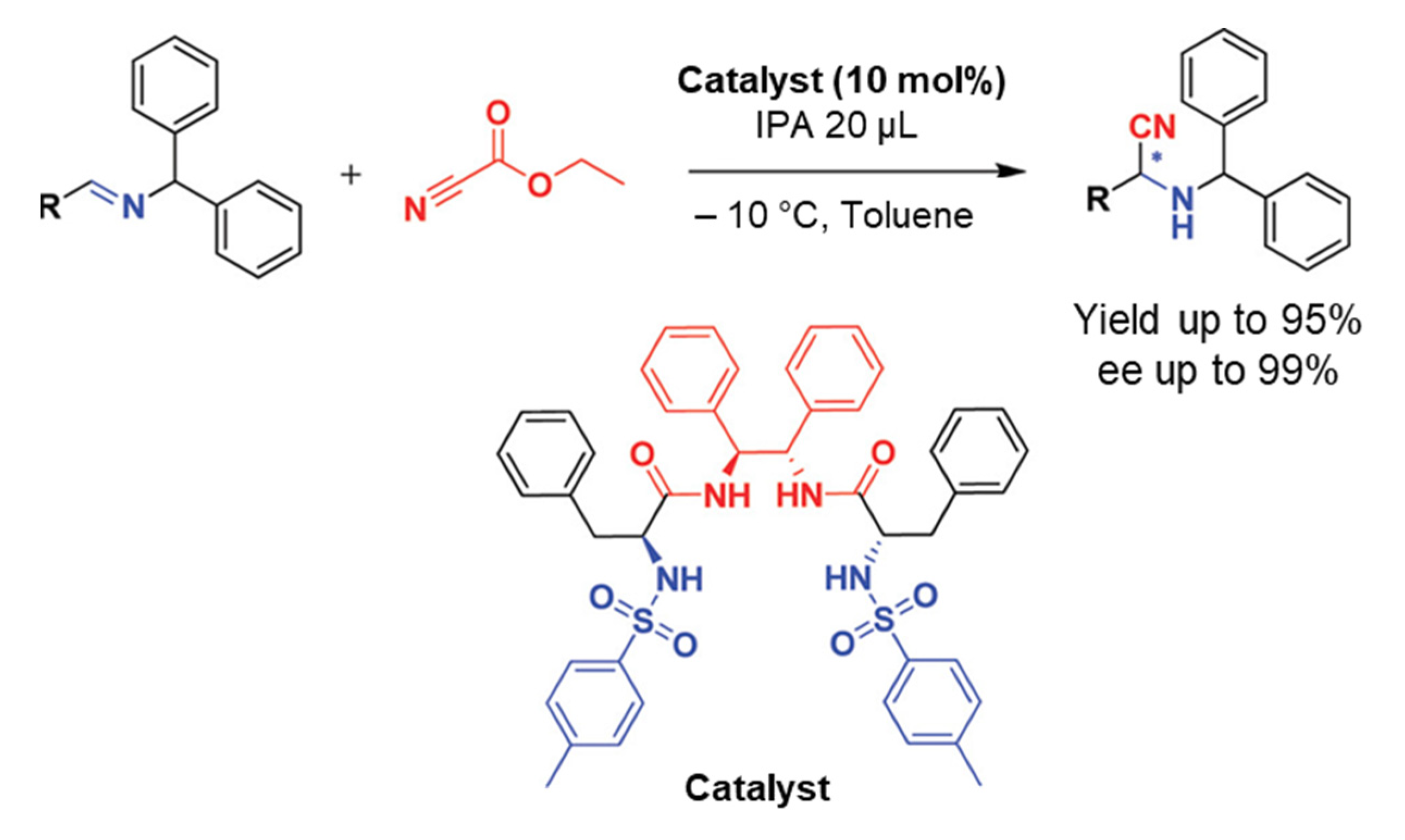
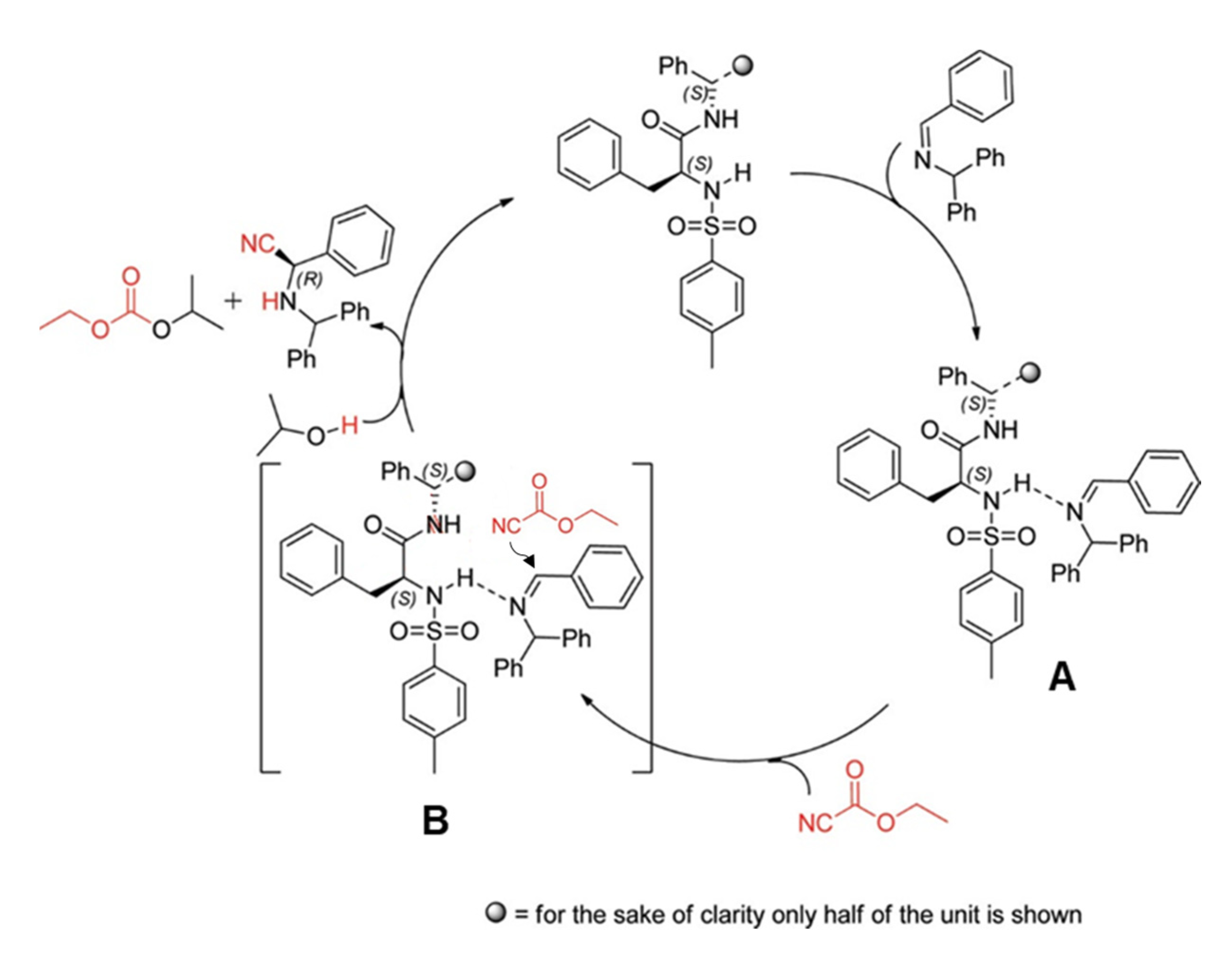



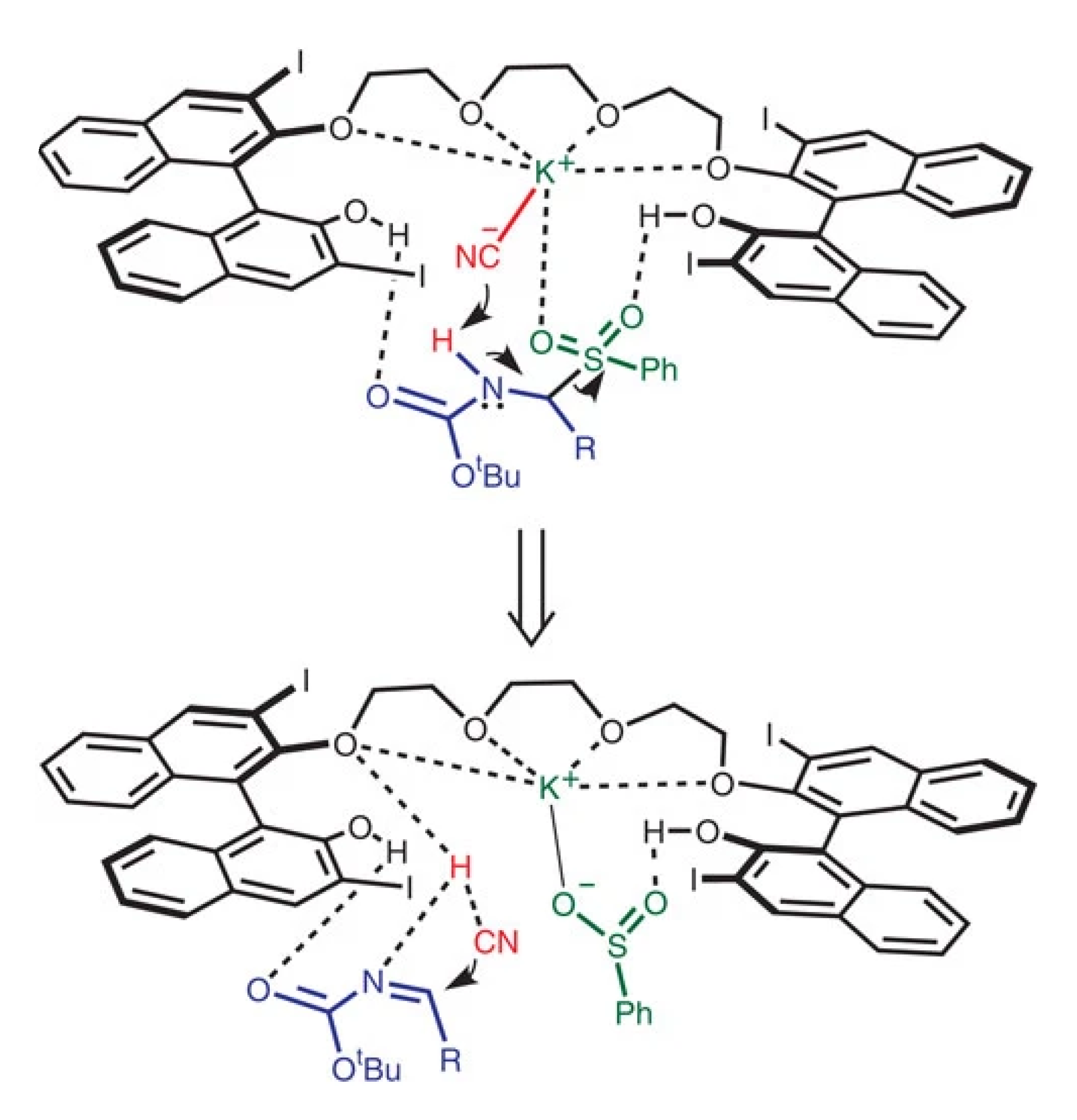
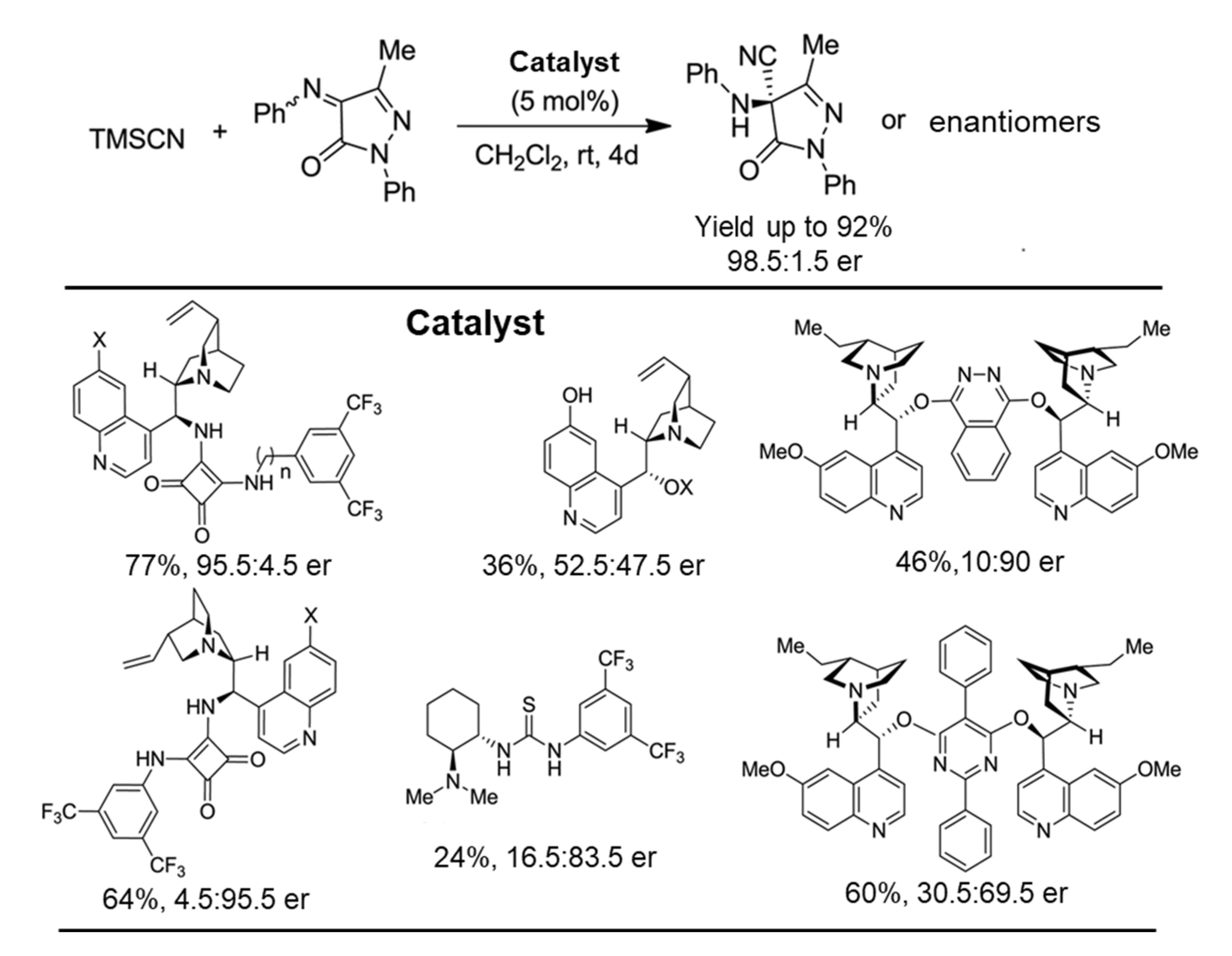

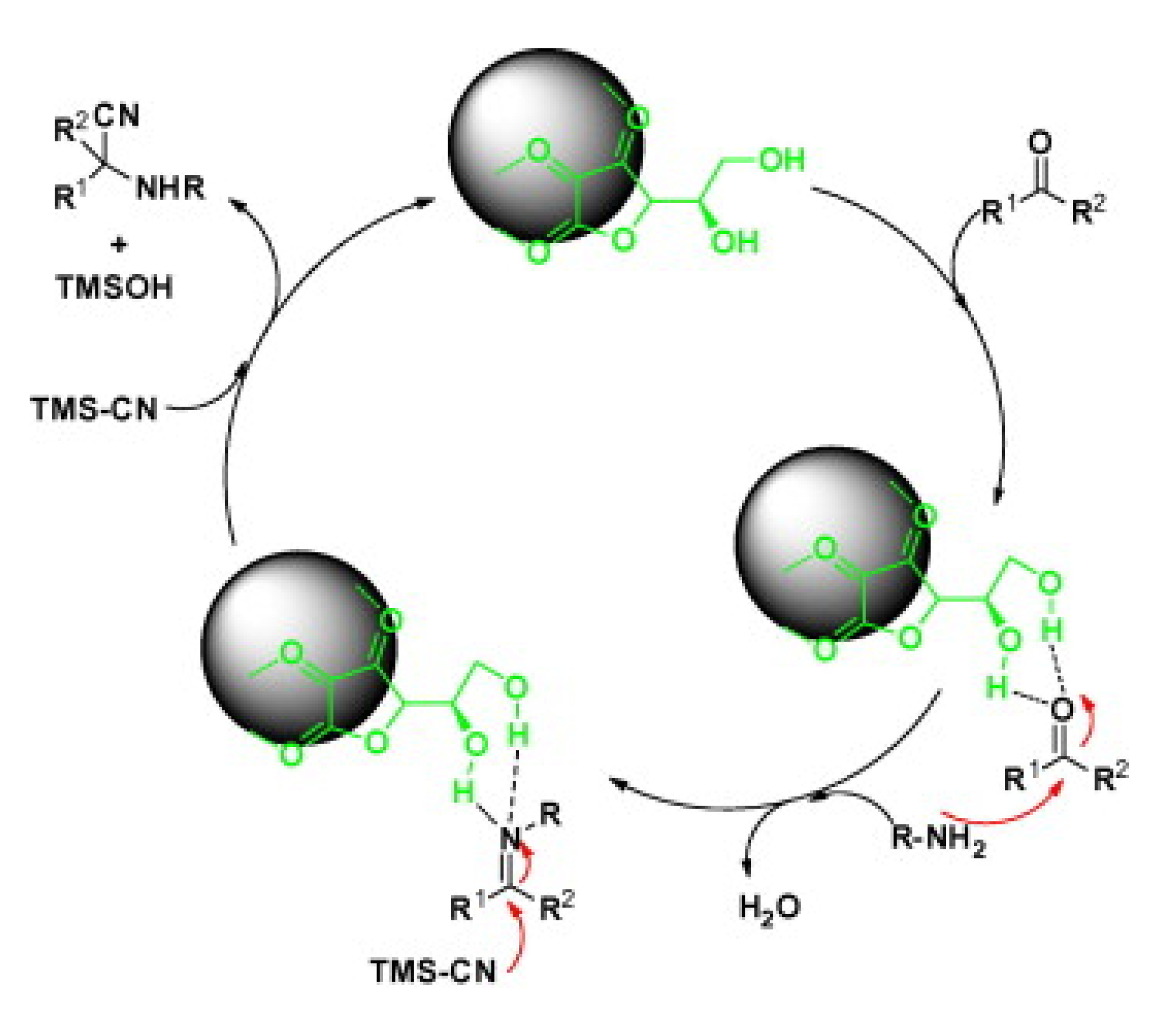
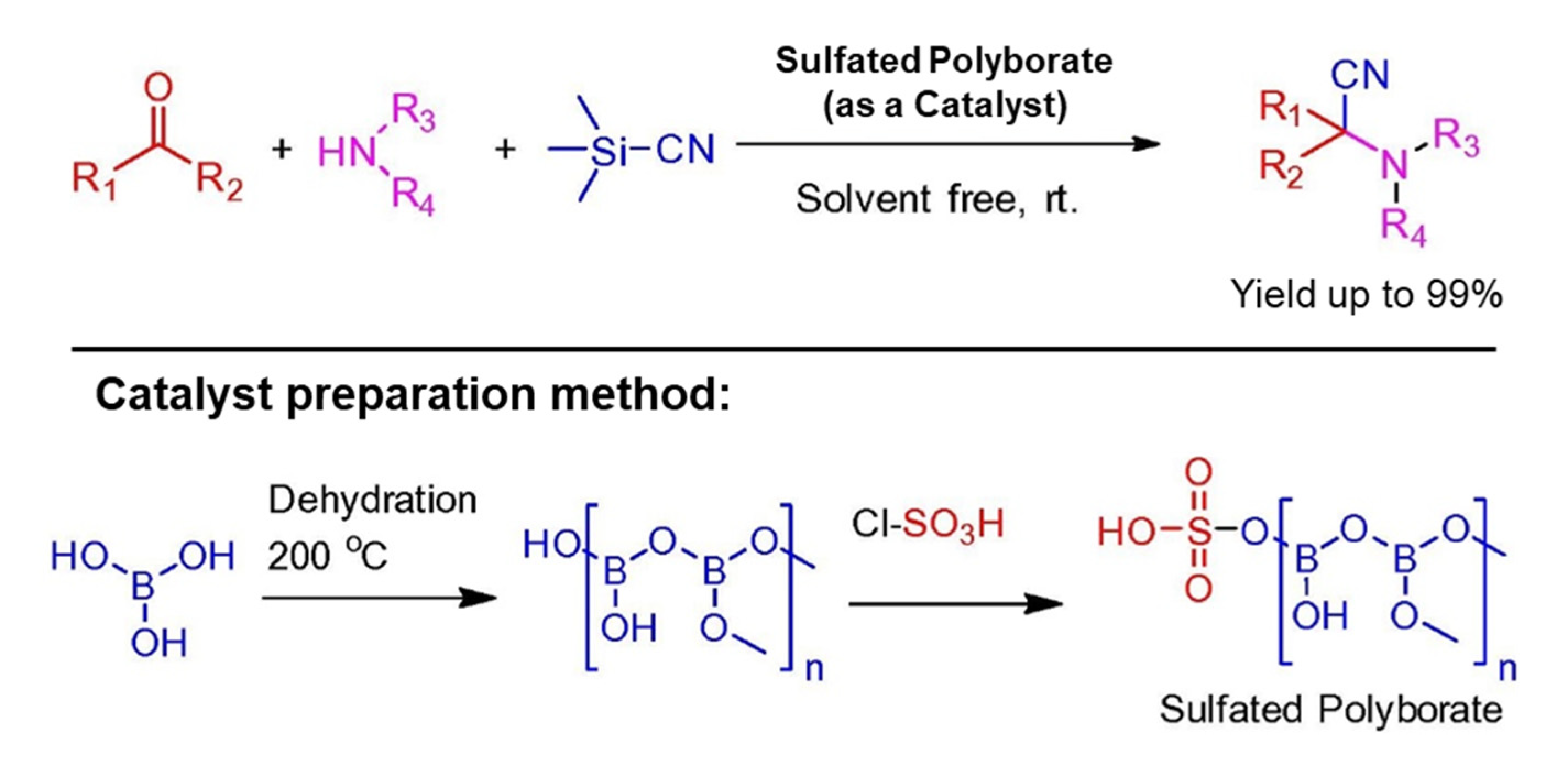
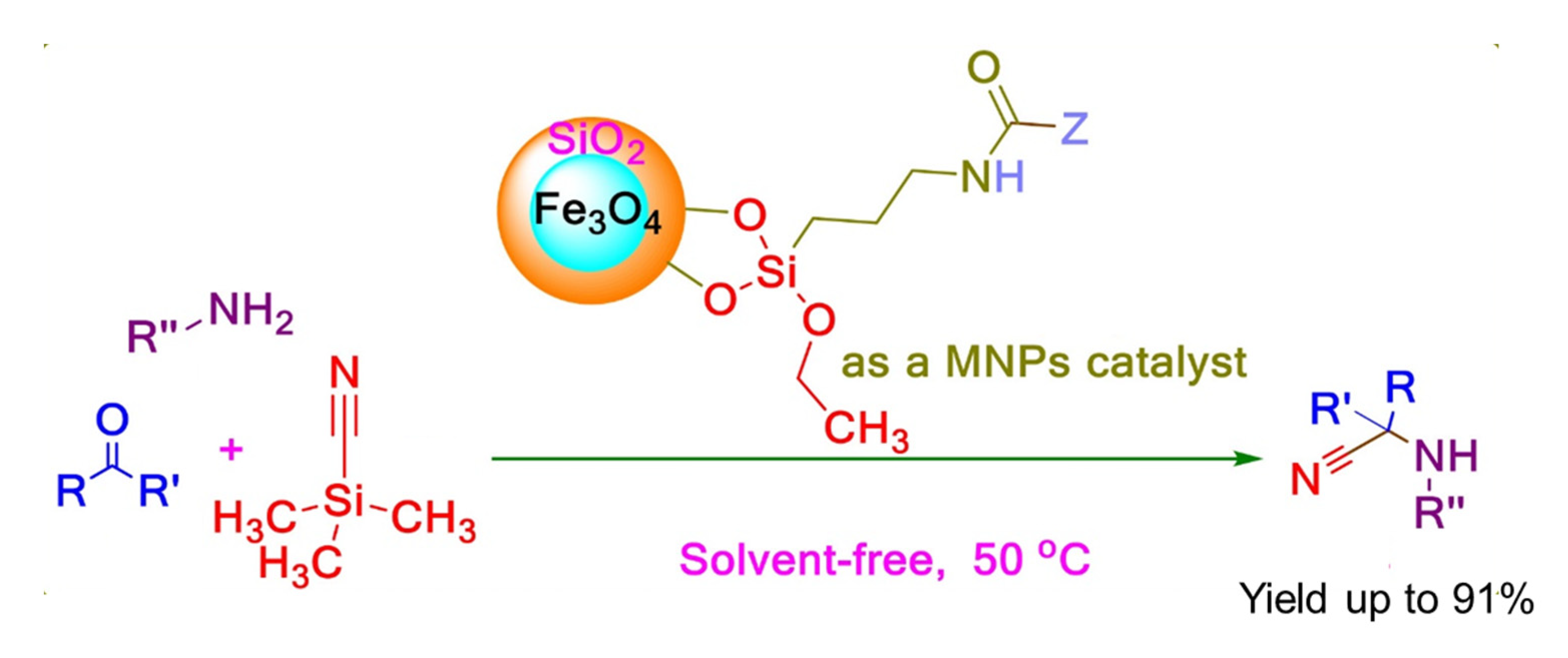
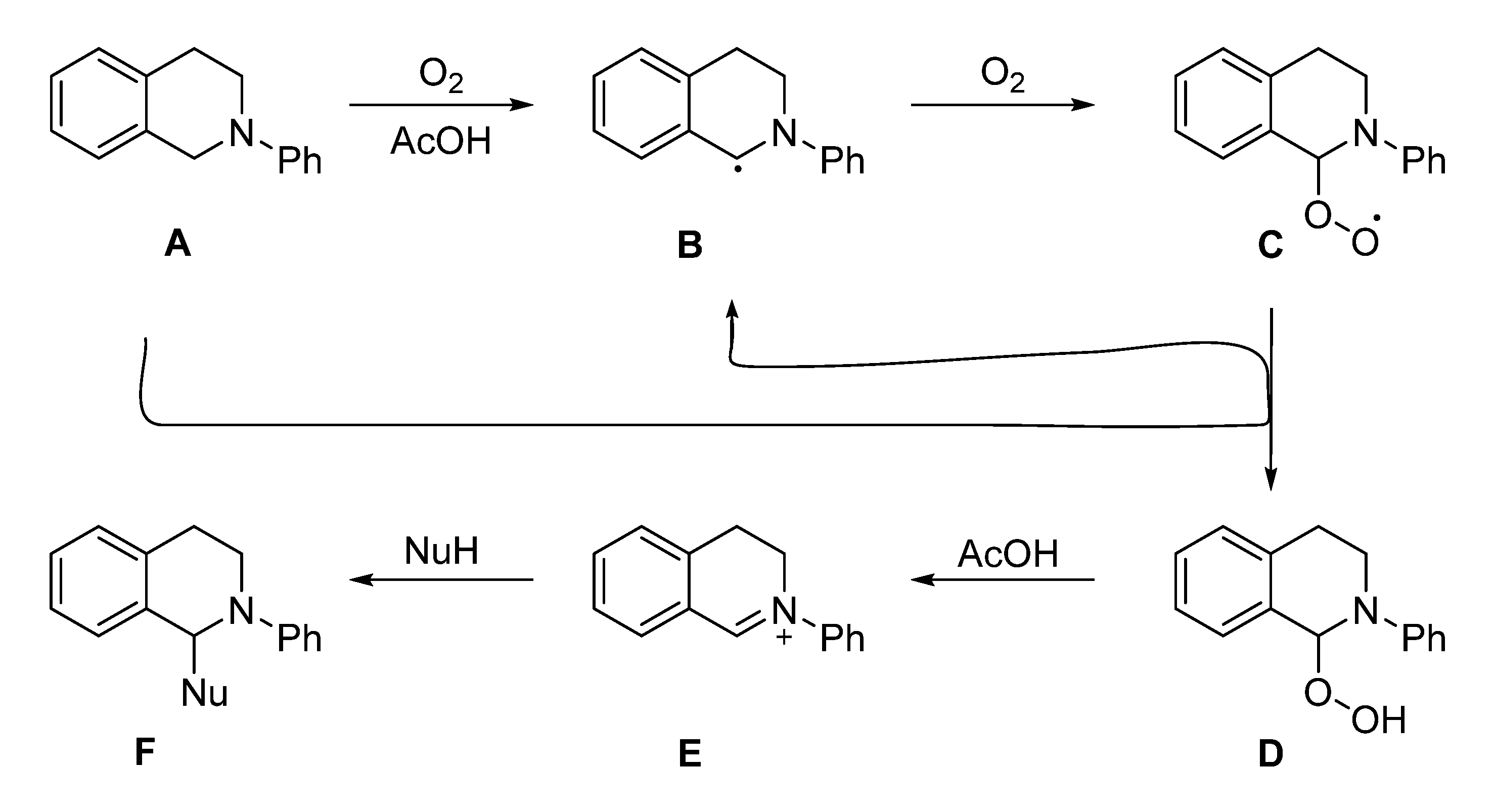
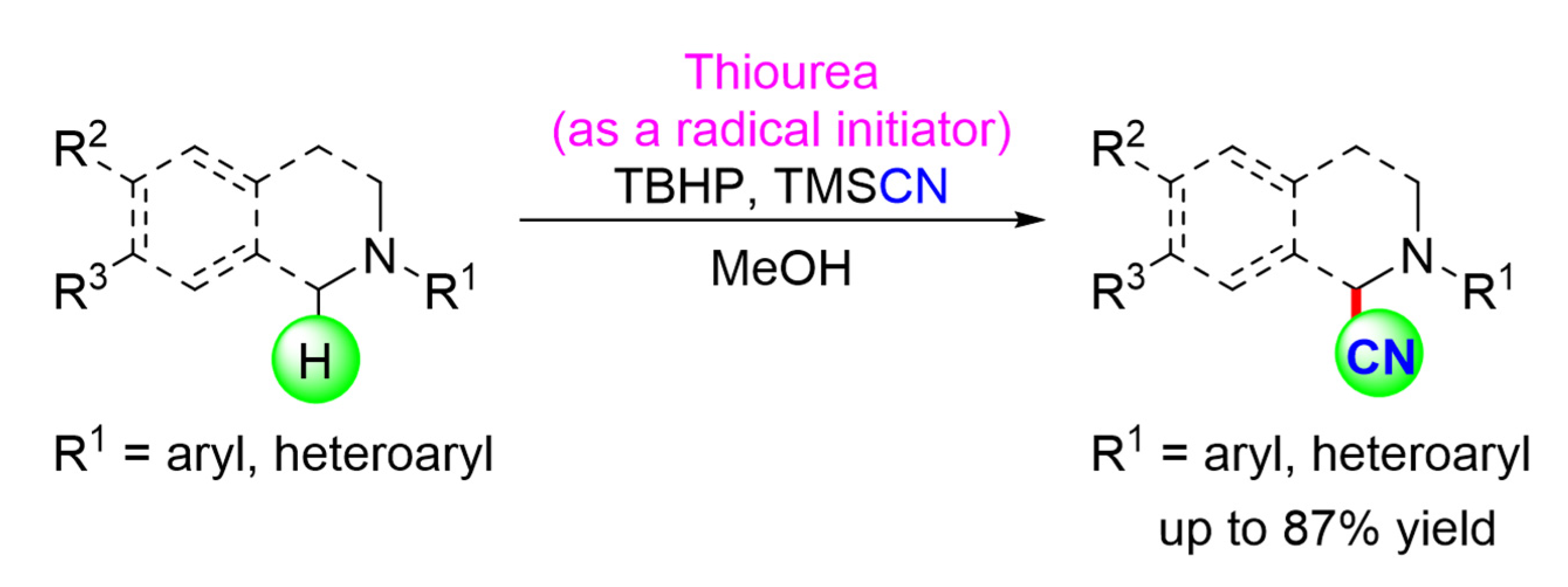
Publisher’s Note: MDPI stays neutral with regard to jurisdictional claims in published maps and institutional affiliations. |
© 2022 by the authors. Licensee MDPI, Basel, Switzerland. This article is an open access article distributed under the terms and conditions of the Creative Commons Attribution (CC BY) license (https://creativecommons.org/licenses/by/4.0/).
Share and Cite
Ullah, B.; Gupta, N.K.; Ke, Q.; Ullah, N.; Cai, X.; Liu, D. Organocatalytic Synthesis of α-Aminonitriles: A Review. Catalysts 2022, 12, 1149. https://doi.org/10.3390/catal12101149
Ullah B, Gupta NK, Ke Q, Ullah N, Cai X, Liu D. Organocatalytic Synthesis of α-Aminonitriles: A Review. Catalysts. 2022; 12(10):1149. https://doi.org/10.3390/catal12101149
Chicago/Turabian StyleUllah, Bakhtar, Navneet Kumar Gupta, Quanli Ke, Naseeb Ullah, Xingke Cai, and Dongqing Liu. 2022. "Organocatalytic Synthesis of α-Aminonitriles: A Review" Catalysts 12, no. 10: 1149. https://doi.org/10.3390/catal12101149





